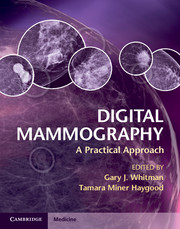Book contents
- Frontmatter
- Contents
- List of contributors
- Preface
- Acknowledgments
- Chapter 1 Detectors for digital mammography
- Chapter 2 Image acquisition
- Chapter 3 Preparing digital mammography images for interpretation
- Chapter 4 Image display and visualization in digital mammography
- Chapter 5 PACS, storage, and archiving
- Chapter 6 Interpretation of digital screening mammography
- Chapter 7 Efficacy of digital screening mammography
- Chapter 8 Artifacts in digital mammography
- Chapter 9 Mobile digital mammography
- Chapter 10 Procedures with digital mammography
- Chapter 11 Digital breast tomosynthesis
- Chapter 12 Breast computed tomography
- Chapter 13 Cases
- Chapter 14 Comparison of commercially available systems
- Index
- References
Chapter 1 - Detectors for digital mammography
Published online by Cambridge University Press: 05 December 2012
- Frontmatter
- Contents
- List of contributors
- Preface
- Acknowledgments
- Chapter 1 Detectors for digital mammography
- Chapter 2 Image acquisition
- Chapter 3 Preparing digital mammography images for interpretation
- Chapter 4 Image display and visualization in digital mammography
- Chapter 5 PACS, storage, and archiving
- Chapter 6 Interpretation of digital screening mammography
- Chapter 7 Efficacy of digital screening mammography
- Chapter 8 Artifacts in digital mammography
- Chapter 9 Mobile digital mammography
- Chapter 10 Procedures with digital mammography
- Chapter 11 Digital breast tomosynthesis
- Chapter 12 Breast computed tomography
- Chapter 13 Cases
- Chapter 14 Comparison of commercially available systems
- Index
- References
Summary
Introduction
Mammography is the most technically demanding radiographic modality, requiring high spatial resolution, excellent low contrast discrimination, and wide dynamic range. The development of dedicated mammography systems [1] in the mid-1960s and the refinements in film-screen technology over its long evolution [2,3] were of critical importance in establishing the benefits of mammography in reducing breast cancer mortality [4–10]. The use of film-screen technology over 30 years ensured excellent spatial resolution under optimal conditions. The high spatial resolution requirement was thought to be essential for imaging small and subtle calcifications as small as 100–200 μm, in particular for visualizing its morphology. In spite of the excellent imaging characteristics of film-screen technology under optimal exposure and film development conditions, intrinsically images are more susceptible to artifacts. Small deviations from optimal exposure and processing conditions can have profound effects on mammographic image quality, such as its ability to provide a balanced image over regions of the breast that vary in radiographic density. The well-documented weaknesses of film-screen technology [11–13] include limited dynamic range, limited tolerance to exposure conditions, complexity and instabilities due to the chemical processing of film, and the lack of ability to digitally communicate, store, and enhance the images.
- Type
- Chapter
- Information
- Digital MammographyA Practical Approach, pp. 1 - 17Publisher: Cambridge University PressPrint publication year: 2012



